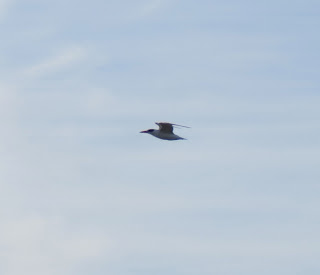Before I continue, I will explain what exactly French Island is. French Island is Victoria's largest offshore island, just a few kilometres north of Phillip Island (see previous posts) in the waters of one of the two bays in the Greater Melbourne Area, Western Port (the other bay is Port Phillip Bay). It is well-known for being the only place in Victoria that is not governed by any shire and thus does not have a council. There are about 80 people who live on the island. Though the people who live on the island can use cars, other cars cannot be brought onto the island from the mainland. The only transport visitors can bring are bikes. The only way to get to the island is on the Island Packers ferry that operates between Cowes in Phillip Island, Tankerton in French Island and Stony Point on the mainland.
Now that my explanation is complete, let's get on with the trip report!
Soon, after about two hours, we were at Stony Point. It was almost 8 o'clock, when the first ferry would go, so we swiftly ran up to the jetty and boarded the ferry. As we left, I noted eastern rosellas in the trees, and several birds on the beaches. Pacific gulls, silver gulls, little pied cormorants, hoary-headed grebes, little black cormorants and white-faced herons were all on the mudflats (it was low tide). We would have gotten to the island at 8:15, but my dad forgot to get off the boat. We had to wait until
the next visit, at 9:00. When we got onto the island, we first had a look around from the jetty. On rocks and flying above us were silver gulls, caspian terns, little black cormorants, little pied cormorants and
Three pied cormorants
A Caspian tern flying past the jetty
pied cormorants. Then, we walked the 2.5 kilometres to the General Store. This, the island's only shop, is basically a cross between a cafe, supermarket, souvenir shop and bookshop. It also hires out bikes. Itwas a very long, very cold walk, but there were birds. At the start of the walk, we could see many brown thornbills in trees on the sides of the road. These thornbills were very common all over the island. Along with the thornbills were New Holland honeyeaters, eastern yellow robins and white-browed scrubwrens, though they were slightly less common. Perched on fences, we could also see a few grey shrike-thrushes. We came out of a small forest and into a more grassland-like area, where I saw an Australasian pipit flying. In a tree we spotted a koala. Soon, we were at the General Store.
Brown Thornbills were common all over the island
After eating some lunch at the General Store we decided to see if we could spot any more birds. First we rode a short distance down Clump Road. We saw two Australian shelducks and a grey currawong, the second of which was a lifer. We rode back and spotted another grey currawong. Then we rode four kilometres down Coastal Road. We spotted blue-winged parrots, New Holland honeyeaters, eastern rosellas, eastern yellow robins and brown thornbills, as well as a juvenile white-bellied sea eagle which soared over the track. We then rode back and left our bikes at the General Store, heading to the jetty to
Eastern rosellas were seen both at Coastal Road and Stony Point
White-bellied sea eagles breed on French Island, here is a juvenile one
wait for the ferry. While at and walking to the jetty we looked for waterbirds and we saw Pacific gulls, grey teals, black swans, masked lapwings, pied oystercatchers, silver gulls and pied cormorants. We decided to take a short walk on the rocky beach and saw starlings, black swans, masked lapwings, pied oystercatchers and a black-shouldered kite in a tree. All too soon it was time to head back from a successful birding trip. We boarded the ferry and went back to Stony Point, where as the sun set I spotted an eastern great egret, a white-faced heron, some Pacific gulls, many silver gulls and a little pied cormorant.
Near the jetty were several pied oystercatchers
Further along the beach we spotted a white blob that turned out to be this black-shouldered kite
BIRD LIST1. Grey Teal
2. Australian Shelduck
3. Black Swan
4. Hoary-Headed Grebe
5. White-Faced Heron
6. Eastern Great Egret
7. Little Black Cormorant
8. Pied Cormorant
9. Little Pied Cormorant
10. Black-Shouldered Kite
11. Masked Lapwing
12. Pied Oystercatcher
13. Silver Gull
14. Pacific Gull
15. Caspian Tern
16. Eastern Rosella
17. Blue-Winged Parrot
18. Brown Thornbill
19. White-Browed Scrubwren
20. New Holland Honeyeater
21. Eastern Yellow Robin
22. Grey Shrike-Thrush
23. Australian Magpie
24. Grey Currawong
25. Little Raven
26. Australasian Pipit
27. Common Starling
28. White-Bellied Sea Eagle
29. Purple Swamphen
MAMMALS
1. Koala







No comments:
Post a Comment